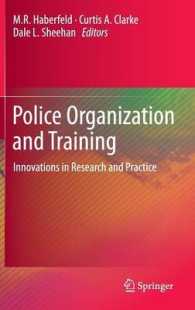- ホーム
- > 洋書
- > 英文書
- > Business / Economics
Full Description
Since this classic book was first published in 2003, sustainability has increasingly become mainstream business for leading corporations, whilst the topic itself has also been a hotly debated political issue across the globe. The sustainability phase models originally discussed in the book have become more relevant with ever more examples of organizations at later stages in the development of corporate sustainability. Bringing together global issues of ecological sustainability, strategic human resource management, organizational change, corporate social responsibility, leadership and community renewal, this new edition of the book further develops its unified approach to corporate sustainability and its plan of action to bring about corporate change. It integrates new research and brings illustrative case studies up to date to reflect how new approaches affect change and leadership. For the first time, a new positive model of a future sustainable world is included - strengthened by references to the global financial crisis, burgeoning world population numbers and the rise of China. With new case studies including BP's Gulf oil spill and Tokyo Electric Company's nuclear reactor disaster, this new edition will again be core reading for students and researchers of sustainability and business, organizational change and corporate social responsibility.
Contents
Part ICorporate Sustainability 2. The Drivers of Change Part II: Managing the Persistent Past: Dealing with First Wave Corporations 3. Corporate Pre-compliance and Compliance Part III: The Dominant Current Reality: Understanding and Reconstructing Second Wave Corporations 4. Achieving Sustainable Operational Efficiencies 5. Sustainability: The Strategic Advantage 6. The Sustaining Corporation Part IV: Pathways to Sustainability: Towards Third Wave Corporations 7. The Incremental Path 8. The Transformational Path 9. Leading Towards Sustainability Chapter 1This chapter explains the pressing reasons for corporations to implement sustainability and summarises the key points of the sustainability phase model in terms of human and ecological sustainability.Chapter 2This chapter provides a detailed description of the drivers of change towards sustainability, summarising the key points of the business case for sustainabilityChapter 3This chapter gives examples of organisations that are either rejecting or being non-responsive to sustainability. It defines compliance and explains the changes that need to be made for the organisation to reach compliance.Chapter 4This chapter explains what it means to be in the efficiency phase of sustainability, and summarises the key steps that organisations need to take to reach this phase.Chapter 5This chapter explains what it means to be in the strategic proactivity phase of sustainability, and summarises the key steps that organisations need to take to reach this phase.Chapter 6This chapter explains what it means to be in the ideal phase of sustainability, and summarises the key steps that organisations need to take to reach this phase.Chapter 7This chapter sets out the steps involved in incremental change for sustainability and shows how it relates to the phase model. Chapter 8This chapter sets out the steps involved in transformational change for sustainability and shows how it relates to the phase model. Chapter 9This chapter explains the importance of change agent mastery and summarises different approaches to leadership and how they might progress sustainability.







